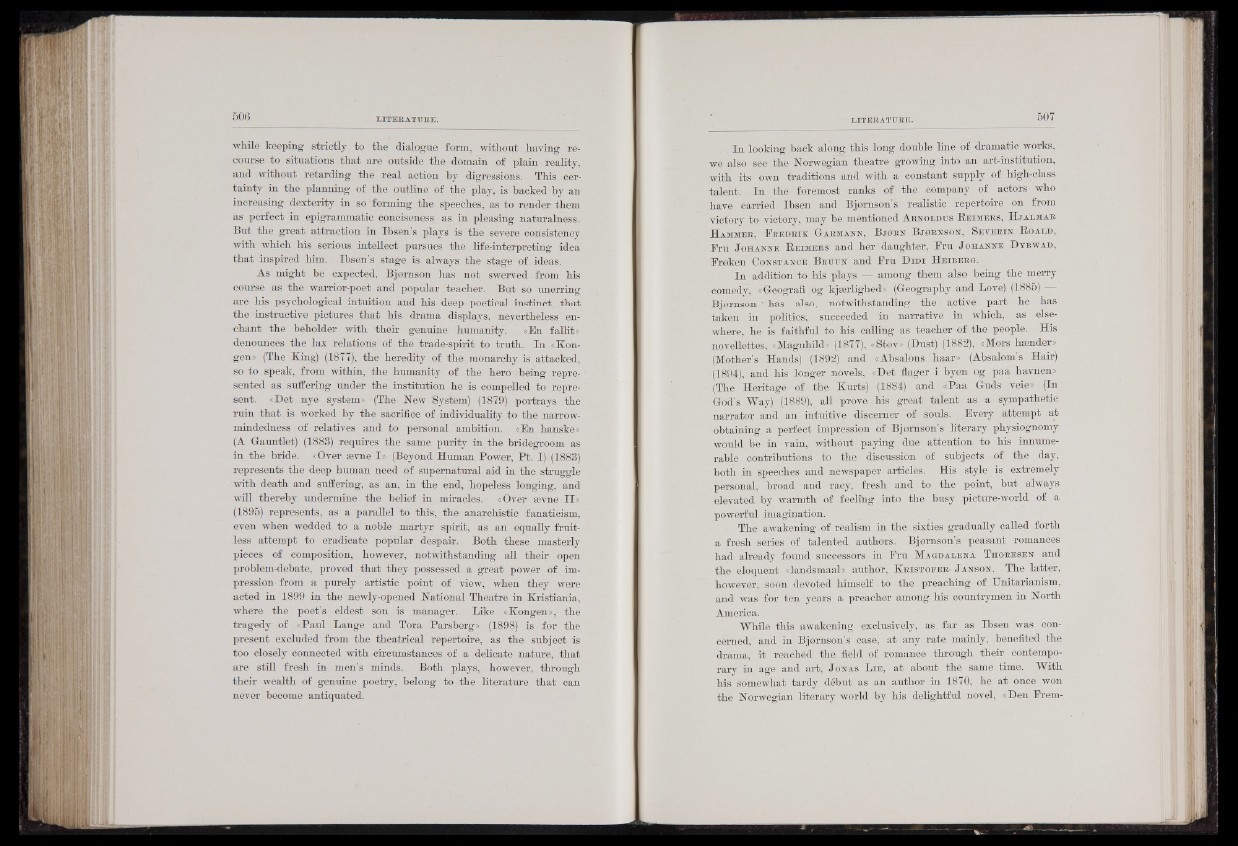
while keeping strictly to the dialogue form, without having recourse
to situations that are outside the domain of plain reality,
and without retarding the real action by digressions. This certainty
in the planning of the outline of the play, is backed by an
increasing dexterity in so forming the speeches, as to render them
as perfect in epigrammatic conciseness as in pleasing naturalness.
But the great attraction in Ibsen’s plays is the severe consistency
with which his serious intellect pursues the life-interpreting idea
that inspired him. Ibsen’s stage is always the stage of ideas.
As might be expected, Bjornson has not swerved from his
course as the warrior-poet and popular teacher. But so unerring
are his psychological intuition and his deep poetical instinct, that
the instructive pictures that his drama displays, nevertheless enchant
the beholder with their genuine humanity. «En fallit»
denounces the lax relations of the trade-spirit to truth. In «Kon-
gen» (The King) (1877), the heredity of the monarchy is attacked,
so to speak, from within, the humanity of the hero being represented
as suffering under the institution he is compelled to represent.
«Det nye system» (The New System) (1879) portrays the
Tuin that is worked by the sacrifice of individuality to the narrowmindedness
of relatives and to personal ambition. «En hanske»
(A Gauntlet) (1883) requires the same purity in the bridegroom as
in the bride. «Over sevne 1» (Beyond Human Power, Pt. I) (1883)
represents the deep human need of supernatural aid in the struggle
with death and suffering, as an, in the end, hopeless longing, and
will thereby undermine the belief in miracles. «Over eevne II»
(1895) represents, as a parallel to this, the anarchistic fanaticism,
even when wedded to a noble martyr spirit, as an equally fruitless
attempt to eradicate popular despair. Both these masterly
pieces of composition, however, notwithstanding all their open
problem-debate, proved that they possessed a great power of impression
from a purely artistic point of view, when they were
acted in 1899 in the newly-opened National Theatre in Kristiania,
where the poet’s eldest son is manager. Like «Kongen», the
tragedy of „«Paul Lange and Tora Parsberg» (1898) is for the
present excluded from the theatrical repertoire, as the subject is
too closely connected with circumstances of a delicate nature, that
are still fresh in men’s minds. Both plays, however, through
their wealth of genuine poetry, belong to the literature that can
never become antiquated.
In looking back along this long double line of dramatic works,
we also see the Norwegian theatre growing into an art-institution,
with its own traditions and with a constant supply of high-class
talent. In the foremost ranks of the company of actors who
have carried Ibsen and Bjomson’s realistic repertoire on from
victory to victory, may be mentioned A r n o l d u s R e im e r s , H j a l m a r
H a m m e r , E r e d r i k G a r m a n n , B j o r n B .io r n s o n , S e v e b in R o a l d ,
Fru .1 oh a n \ k R e im e r s and her daughter, Eru J o h a n n e D v b w a d ,
Proken C o n s t a n c e B r u u n and Eru D i d i H e i b e r g .
In addition to his playsfflS among them also being the merry
comedy, «Geografi og kjærlighed» (Geography and Love) (1885) —
Bjornson ' has also, notwithstanding the active part he has
taken, in politics, succeeded in narrative in which, as elsewhere,
he is faithful to his calling as teacher of the people. His
novelettes, «Magnhild» (1877), «Stov» (Dust) (1882), «Mors hænder»
(Mother’s Hands) (1892) and «Absalons haar» (Absalom’s Hair)
(1894), and his longer novels, «Det flager i byen og paa havnen»
(The Heritage of the Kurts) (1884) and «Paa Guds veie» (In
God’s Way) (1889), a l prove his great talent as a sympathetic
narrator and an intuitive discerner of souls. Every attempt at
obtaining a perfect impression of Bjornson’s literary physiognomy
would be in vain, without paying due attention to his innumerable
contributions to the discussion of subjects of the day,
both in speeches and newspaper articles. His style is extremely
personal, broad and racy, fresh and to the point, but always
elevated by warmth of feel&g into the busy picture-world of a
powerful imagination.
The awakening of realism in the sixties gradually caled forth
a fresh series of talented authors. Bjornson’s peasant romances
had already found successors in Eru M a g d a l e n a T h o r e s e n and
the eloquent «landsmaal» author, K r i s t o f e r - J a n s o n . The latter,
however, soon devoted himself to the preaching of Unitarianism,
and was for ten years a preacher among his countrymen in North
America.
While this awakening exclusively, as far as Ibsen was concerned,
and in Bjornson’s case, at any rate mainly, benefited the
drama, it reached the field of romance through their contemporary
in age and art, J o n a s L i e , at about the same time. With
his somewhat tardy début as an author in 1870, he at once won
the Norwegian literary world by' his delightful novel, «Den Erem